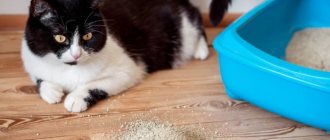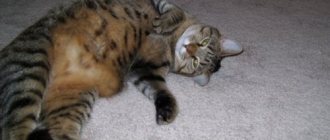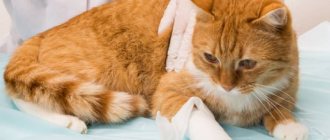In cats, as in people, atony refers to dysfunction of the striated or smooth muscles of organs, including the bladder. Simply put, the animal is unable to control urination, which causes a lot of inconvenience for the owner and pain for the pet itself. Fortunately, bladder atony in cats can be successfully treated without relapse with proper care and prevention. Below we will tell you how to recognize signs of atony in a cat, what factors cause this disease, as well as treatment and preventive measures.
Bladder atony in a cat: symptoms and treatment
Causes of bladder atony in cats
There are many factors that result from dysfunction of the bladder muscles, and many of them are associated with improper husbandry of cats. First of all, atony is provoked by excessive or poor-quality feeding. If an animal regularly receives food poor in nutrients, the diet does not include fiber and coarse carbohydrates, intestinal motility weakens and is disrupted, and then “pulls” a decrease in the motility of the muscles of the adjacent bladder.
A properly formulated diet is the key to the health of a domestic cat.
Despite the fact that some cat owners disdain dry commercial foods, pets receiving these holistic or super premium foods almost never suffer from diet-related bladder atony.
Brief characteristics of holistic food for cats
Also, atony can occur due to the cat’s advanced age, when the muscles begin to work worse and become worn out. This factor is directly related to how the animal ate throughout its life and how attentive the owner was to his mustachioed friend. The best prevention of age-related bladder atony in a cat is proper care from a very early age.
Parasites in the gastrointestinal tract can also affect the motility of the muscles of all digestive organs and reduce the tone of the walls of the bladder. Just like in the human body, in a cat’s body everything is interconnected. Do not forget about regular anthelmintic treatment of your cat in order to protect it not only from worms and other pests, but also from concomitant diseases.
Banal worms in cats can cause more serious illnesses
Physiological causes that cause bladder atony are identified. This can be stones and sand in the bladder cavity, in cats - inflammation of the prostate gland, untreated cystitis and urethritis. Inflammation of the bladder due to hypothermia or infectious diseases is also a direct path to atony if the owner did not notice the problem in time and did not take measures for treatment.
Atony can also be caused by injuries to the spine or groin area, as a result of which the innervation of the nerve endings in the walls of the bladder is interrupted. If an animal falls out of a window, becomes the victim of an aggressive dog, or gets hit by a car, the consequences can include more than just external damage.
The cat owner must be vigilant and protect it from the most obvious dangers
How to treat a pet
Injections for a cat
how to treat a cat for cystitis? Some people immediately begin to study forums in search of traditional methods of treating a cat for cystitis, others ask neighbors and friends. Most people start treatment with the drug stop cystitis, but the fact is that the drug only relieves symptoms, but does not eliminate the root cause.
- Antibiotics are most often prescribed. Even if bacteria are not the culprit, sooner or later pathogenic microorganisms attack the inflamed area. Without them, it is unlikely that it will be possible to achieve a full recovery. Ask your veterinarian to test the sensitivity of bacteria in the urine to antibiotics to avoid giving your pet medications that will not help him.
- To prevent antibiotics from leading to dysbiosis, a qualified veterinarian will prescribe probiotics (drugs that restore intestinal microflora). Only they should not be given immediately after or before the administration of antibiotics. Otherwise, probiotics will be of no use.
- Antispasmodics. They will help the animal “relax” a little. Firstly, the cat will be able to pee (it won’t hurt as much, and the inflammation will decrease a little). Secondly, this will allow the cat to excrete more urine at one time, it will not stagnate.
- Be sure to eliminate the cause! If this is a metabolic disorder, then completely review your diet and be sure to filter the water. If ICD has already developed, then you need to deal with it. If other chronic diseases are the cause, then they are eliminated.
- If a cat has idiopathic cystitis, then it is very difficult to treat. The whole problem is that, as stated above, the reasons for its occurrence have not yet been discovered. Therefore, the veterinarian has to prescribe symptomatic treatment (for example, stop cystitis, diuretics, antibiotics).
We suggest you read: What to do if your cat has blood in his ear
Bladder atony in cats: symptoms
The weakening of the functions of the bladder muscles in cats manifests itself clearly, but develops quickly. First of all, the owner may notice that the cat’s appetite has decreased, the animal has become lethargic, and has become less likely to go to the toilet. A cat can come to the litter box many times a day, but urinate every other time, sometimes there is no urination at all.
Urine accumulates in the organ, causing severe intoxication, and ultimately the animal may die due to a ruptured bladder. In acute cases, only 20-25 hours may pass from the exacerbation of the disease to the death of the cat. But, as a rule, such a rapid development of the disease is unusual for domestic cats, and the owner has enough time to help the pet.
A sick cat avoids affection and moves little
It is very easy to discover that something is wrong with a cat. At the onset of atony, the animal will appear restless, often going to the litter box, trying to go to the toilet. It can be seen that the pet is straining, looking for a comfortable position, but urination does not occur. As a rule, with atony, a few drops are poured out, and the urine often contains an admixture of blood or takes on a pink tint.
After several attempts to visit the toilet, the cat will most likely lie down next to you, since constant movements cause her discomfort. At this moment, the pet will not be happy about affection from the owner, the cat may scream if a person tries to pick it up, and when trying to disturb the cat, the owner must understand: at this moment, urination may occur involuntarily.
With atony, a cat may urinate blood
First aid
In a situation where a cat cannot pee, what should you do at home? First, it’s worth checking whether anything has changed in the cat’s life:
- castration;
- moving;
- change of owners;
- change of feed;
- low activity after illness;
- drug treatment;
- other surgical interventions.
If none of this has happened in the cat’s life, and the behavior is very different from usual, it is important to help him.
- Place a warm heating pad or compress on your stomach and perineal area. Make sure that the cloth or heating pad is not too hot. It is necessary to warm, but not burn the abdominal cavity;
- place the animal in a bath or basin at a comfortable temperature. It is necessary to ensure that the water does not reach the heart area;
- control the volume drunk. The animal must drink a lot. If it refuses, it is allowed to pour in a little from a pipette.
A good way to help him cope with his illness is to play with him if he is active. But you shouldn’t force your cat to do this, especially if it’s hard for him.
Diagnosis and treatment of bladder atony
At the first symptoms indicating problems with the bladder, the animal should be taken to a veterinary clinic. The veterinarian will examine the cat, palpate the bladder, prescribe urine and blood tests, and an ultrasound of the abdominal organs. These studies are often sufficient to make a diagnosis.
The main danger of bladder atony is the possibility of organ rupture, followed by the inevitable death of the animal. Therefore, if there are signs of a full bladder (easily determined by manual examination of the animal), the veterinarian will insert a catheter through which the accumulated urine will come out. This procedure can be painful for the animal, so it is often done under sedation or complete anesthesia.
The veterinarian will help the cat urinate and empty its bladder.
The catheter can be left in place for some time while the disease is being treated, since the bladder will overflow and constantly threaten the pet’s life. Usually, owners are advised to put a special diaper on the cat while the catheter is worn. This is due to the fact that the catheter does not allow the animal to regulate urination - it simply drains urine as soon as it accumulates.
Cats quickly get used to wearing a diaper, and this measure allows not only to maintain hygiene in the apartment or other room where the animal lives, but also helps the pet itself not to get dirty. After all, you only need to wear diapers for a few days.
Cat diapers with a slit for a tail are sold in pet stores.
Treatment will be individual in each case, however, there are effective and proven drugs that are usually included in the therapeutic method for treating bladder atony. Please note that in no case should you self-medicate, since not only the choice of medication is important, but also its dosage, regimen and duration of administration.
Table. Drugs that treat bladder atony in cats
| A drug | Indications |
"CatErvin" | Herbal medicine in the form of a drinking solution. Indicated for the prevention and treatment of urological diseases in cats, removes salts, dissolves stone formations, has an anti-inflammatory and diuretic effect |
| "Prozerin" | A medicine produced in the form of an injection solution. Stimulates and improves the tone and motility of the bladder walls, relieves the effects of intoxication |
"Furagin" | Tablet preparation with a good antimicrobial effect. Relieves pain symptoms, stops inflammatory processes in organs |
Only a qualified veterinarian can prescribe medication
Important point! Bladder atony in cats is a serious disease, delaying treatment of which is dangerous for the pet’s life. At the same time, only a veterinarian in a clinical setting has the right to make all decisions regarding therapy and other medical procedures.
Video - Manual bladder emptying in a cat
Treatment of cystitis
Therapy for this disease solves several problems at once:
- Relieves spasms, eliminates pain - for this, antispasmodics and analgesics are prescribed.
- Neutralizes the cause of the inflammatory process and suppresses bacterial pathogens - correctly prescribed antibiotics can cope with this problem.
- Cleanses the inflamed organ from pathogenic contents - for this, liquids that have an antiseptic and antibacterial effect are introduced through a catheter.
- Eliminates dehydration - the animal is given IVs.
Prevention of bladder atony in cats
Each owner of a domestic cat can make his or her contribution to the prevention of such an unpleasant disease as bladder atony. You don't need to do anything special to prevent illness. It is enough to provide the animal with the right diet, excluding cheap factory feed, “naked” meat and fish (the addition of fiber and carbohydrates is mandatory), and promptly treat the cat if it is sick with something (especially an inflammatory or infectious disease).
Prevention of atony in cats - proper care and feeding
The cat needs to be provided with constant access to clean water (in regions where tap water flows from the tap containing many salts or metals, filtered or bottled water should be used). It is important to protect your pet from possible injuries: do not let him go outside unattended, do not leave windows open.
Symptoms of the disease
The main symptom of cystitis is difficulty urinating
Unfortunately, the cat is not able to say what is bothering her. Therefore, the owner must regularly monitor the animal in order to respond in a timely manner if a problem arises. The symptoms of the disease are the same, regardless of the form of the disease. The only exception is hemorrhagic cystitis, when you can see blood in the urine.
The disease can be identified by the following signs:
- frequent urge to urinate;
- painful sensations when visiting the tray, which can be recognized by characteristic sounds. The cat begins to meow pitifully, especially at the end of urination;
- pain in the lower abdomen. When stroking this area, the animal becomes restless and turns away;
- the presence of pus and blood in the urine (hemorrhagic form);
- unpleasant odor coming from urine;
- a decrease in the animal’s appetite or complete refusal of food;
- temperature increase. For a cat, the norm is 38°C.. 39°C;
- demonstrative urination in inappropriate places. In this way, the animal tries to attract attention and communicate a problem.











